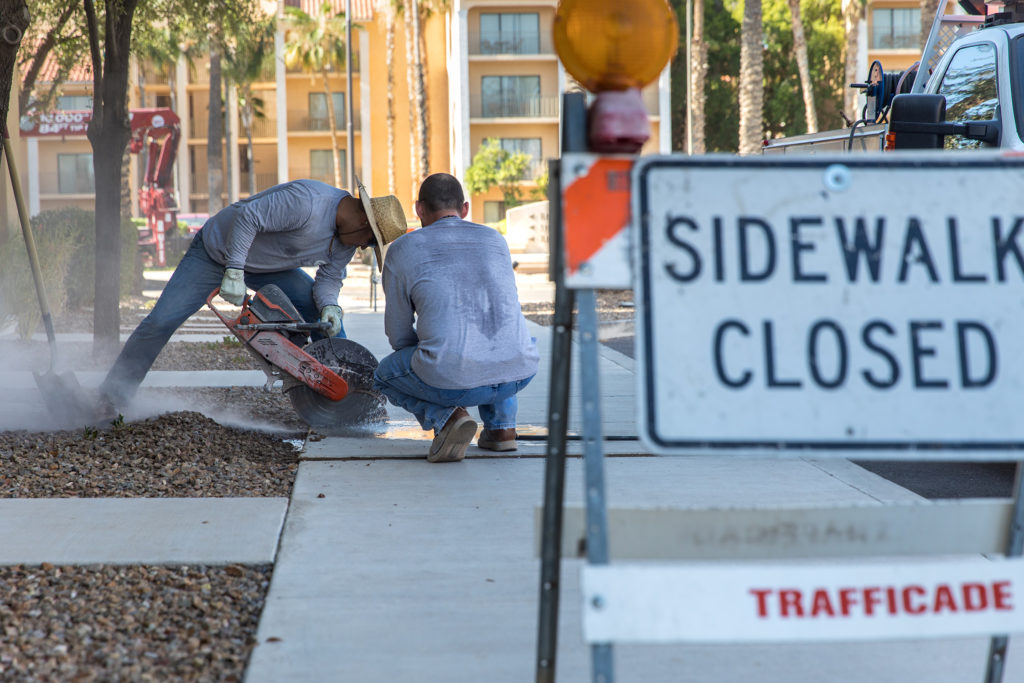
Removing barriers to mobility is a priority for the city. – Photo courtesy city of Chandler
By Sammie Ann Wicks
For many of us, strolling down a city sidewalk or crossing the street to go to our favorite restaurant are things we take for granted, but these seemingly simple everyday maneuvers aren’t that easy for people with disabilities.
According to WalletHub, a financial website that produces state and local rankings on a number of topics, the city of Chandler has been ranked among the best places to live for those with disabilities.
WalletHub compared some of America’s most populated cities across 31 key indicators of disability-friendliness, including physicians per capita, park accessibility and rate of workers with disabilities. Chandler ranked 11th out of 182 cities, ahead of communities such as Minneapolis (#12), Denver (#14), San Diego (#28) and Portland (#30).
“At least in part, I think this high ranking demonstrates the success that the city has had in creating infrastructure and in developing programs that are effective for people with and without disabilities,” said Jason Crampton, Chandler’s Americans with Disabilities Act coordinator. “One of the biggest efforts we make at the city of Chandler is our work on sidewall infrastructure.”
The challenges Chandler’s disabled citizens face in easily getting around the city, however, have been brought into the full light of public awareness by proactive programs designed especially for them. One of these is aimed at making city streets and curbs safe for and accessible to the disabled who have mobility issues.
“We not only invite citizens to call in and alert us to streets and curbs that need attention to accommodate disabled members of the community, we also operate a special staff which patrols the city and does the necessary repairs,” Crampton said. It’s the city’s older sidewalks that need the most attention, he added.
“The newer sidewalks naturally need less attention than the older ones, where we might see a big slope or drop-off that wouldn’t work for the disabled, or might even be dangerous—that’s something we want to jump right on,” Crampton said.
Part of his group’s outreach is with other areas of city government whose activities affect Chandler’s disabled.
“We also work with the parks and recreation people to accommodate our disabled citizens and improve their access there,” noted Crampton. “And obviously we work closely with the city’s traffic staff—even coordinating with them to make sure every intersection and crossing has functioning buttons that are in reach and work for them.”
The coordinator reports that the city works within an ADA 20-year plan to enhance and improve disabled citizens’ access to city resources and services.
“We work continually to do detailed analyses and update our efforts within the plan,” Crampton said, “and it’s this research and evaluation of our progress that has helped Chandler take the lead in serving citizens with different needs.” Crampton hastened to add that an improvement in services to the disabled also positively impacts the needs of other segments of Chandler’s population.
“These developments have improved the lives of our senior citizens, too,” Crampton noted, “because many of them face issues of mobility and access to the same services.”
Chandler’s outreach to special populations is not just focused on city sidewalks and streets, though— its programs have been expanded into a wide range of services supervised by city staffer Collette Prather, who runs Chandler’s therapeutic programs for the community’s special needs and disabled children.
Serving such large numbers of kids makes huge demands on her time and energy, Prather said, but she insisted she’s the recipient of the greatest reward.
“Believe me, these kids give back to me way more than I do for them,” Prather declared, a little out of breath from a long day hosting parties and cleaning up in the aftermath. She believes kids like her young charges inspire her like no other group.
“For the most part, my kids are really upbeat, maybe more so than other people, because they don’t feel the pressures of the world like we do—it’s really refreshing.”
Prather believes it’s the parties and other stimulating activities that make the children’s learning more effective.
“All these social activities, like outings in town— we call them ‘Out and About’—and camping, cooking for other kids at Ronald McDonald House, visiting the zoo, fishing, kayaking, you name it,” Prather said, “it all plays into them learning life tasks and getting adept at their social skills.”
As far as the experience of special needs children in the public schools, Prather said she supports fully integrating them into the regular student population, a practice often-referred to as “mainstreaming.”
“Inclusion, I think, is really important to these kids when they’re in school,” Prather asserted. “In that regard, they’re just like every other child—they want to belong.”
In this, Prather echoes the views of parents of special needs children like Emilio Torres’s mother Denise Torres (see Page 14), who said one of her biggest challenges is convincing schools that special needs children should be fully integrated into the regular classroom.
“They just learn better that way, and are happier,” Torres says.
“Moms like Denise have learned from experience that special needs kids progress faster when they’re learning alongside their peers,” Prather said, “and we hope someday that this will be the norm.”


